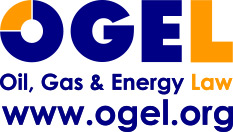OGEL Special Issue: Oil Spills
Article from: OGEL 3 (2010), in Editorial
"From Summer of Optimism to Summer of Despair"
For the world-wide petroleum industry, the spring and summer of 2010, which could have been remembered as the beginning of the process to open more offshore areas of the United States to oil and gas exploration, will instead be remembered as the time of the BP oil spill.[1] The spill began on April 20th with the loss of 11 crew members and the Deepwater Horizon drilling vessel at the Macondo well[2] in the Gulf of Mexico. Oil has stopped flowing into the Gulf, though only after a record spillage that has been estimated at about five million barrels. But the well is not yet plugged, damage assessment and cleanup continue, and litigation of claims and liability is just beginning.
Earlier in April, the U.S. President, with substantial support from the coastal states and their Congressional delegates, had committed the federal government to facilitate additional exploration and development of the U.S. OCS. The Deepwater Horizon tragedy will likely result in keeping U.S. offshore areas off limits at least for the immediate future and delaying and increasing the cost of exploration and development of those areas that remain open, which will make it harder for smaller companies to participate. The spill will likely result in tougher regulation of the oil industry in many parts of the world, but may also make some kinds of exploration and development such as onshore, including tar sands and shale plays and some countries with less regulatory oversight more attractive to investors. But the spill is not likely to lessen the world's reliance on oil. And though disastrous, the incident could have been worse: it could have occurred at a time of tight oil supplies, which would have spiked oil prices, or it could have happened under the supervision of a smaller operator that might not have been able to finance the control of the well and the cleanup of the Gulf.
While BP, some of BP's contractors, and perhaps even the federal government may ultimately share the blame for this spill, the entire petroleum industry will feel the impact. The primary consequence will be more regulation. The only question is the extent to which the United States and other governments will tighten regulatory oversight. Certainly, governments will tighten regulations, but will they strangle the petroleum industry? Will the regulations be politically astute but technically or fiscally unsound? Might they be too weak, too strong, or misdirected? The chances for "just right" regulations are not good. Given the dysfunctional political mood in Washington, Congress may be unable to do anything, but administrative agencies are likely to act with or without Congressional action. At a minimum, market forces will bring about change because those who invest in oil stocks will insist that management pay more attention to safety.
We believe that strong, yet flexible, regulatory oversight could in the medium and long term actually strengthen the petroleum industry, much as oil conservation regulation did in the 1930s. A tough, even-handed regulator with a healthy skepticism for cost, corner-cutting, and time-saving initiatives could be just what the industry needs.[3] Indeed, such a regulator could be the industry's best friend by not permitting operators to engage in cost-saving and time-saving initiatives that offer a competitive advantage over other operators who are unwilling to take unwise risks. Such a regulator would level the playing field for all operators in what is a highly competitive industry,[4] minimize the likelihood of blowouts and other disasters reoccurring, increase public confidence in the petroleum industry and regulatory agencies, and ultimately make more likely the opening of areas now closed to exploration.
Unfortunately, given the partisan extremism in Washington, we are not optimistic about the outcome of regulatory reform. Like Goldilocks' porridge, the resulting regulations are likely to be either too cold accomplishing little in the way of real protection against future disasters or too hot being so onerous that much of the prospective offshore and onshore areas of the United States will remain de facto, if not de jure, off limits. One possible regulatory approach might be to require the drilling contractor and some well-service contractors, and perhaps even non-operators, to assume some regulatory responsibilities such as having an obligation to say "no" to unsafe operations or to report safety concerns to regulatory officials.
In addition to imposing more safety regulation, many governments will most likely increase the liability limits for oil spills. U.S. law relating to liability for oil spills is a hodgepodge of civil and criminal law, both state and federal, including maritime law for offshore spills. Liability depends on the claimant, the defendant, and on the type of claim made. Liability law is influenced by regulations that are aimed at spill prevention, response, and remediation. The Oil Pollution Act (OPA) of 1990, P.L. 101-380, makes the responsible party strictly liable. For spills from vessels, the responsible party is the vessel owner, operator, or charterer, but the responsible party for spills resulting from oil exploration and production facilities is generally the operator the party holding the permit to drill.[5] The responsible party's strict liability under the OPA is capped at US$75 million for offshore spills; however, this cap does not apply to direct clean-up costs and certain claims brought under state law.
Moreover, the liability cap does not apply where the responsible party is grossly negligent, engages in willful misconduct, or violates federal regulations related to the cause of the spill. And the issue of whether OPA preempts general maritime law, which might entertain a negligence action, is unresolved. Further, federal criminal sanctions, such as ones found in the Migratory Bird Treaty Act and National Marine Sanctuaries Act, include fines as well as restitution remedies to the U.S. government.
The OPA also established an oil spill liability trust fund, which is largely funded by a per-barrel tax on oil. When a responsible party is unable to pay for clean-up or for liability or where damages exceed the liability cap, the trust fund pays out up to US$1 billion, basically on a first-come, first-paid basis. The liability cap may be criticized as failing to encourage spill prevention, but the cap is also a trade-off for claimants who can hold the responsible party strictly liable, instead of having to prove negligence or other fault.
Because the OPA does not preempt state law, claimants can sue in state court to recover damages and such claims are not subject to the OPA liability cap. However, state law may require proof of negligence or other fault and state oil spill legislation may establish a state liability cap. And although maritime law is federal in the US, certain in personam common-law claims can be brought in state court under the so-called "Savings to Suitors Clause," 28 U.S.C. § 1331(1).
This hodgepodge of law is rounded out (1) by the federal Limitation of Vessel Owner's Liability Act, 46 U.S.C. §§ 181-196, which limits the liability of a vessel owner to the value of the cargo and vessel after the casualty unless it is found to be negligent, and (2) by the doctrine of Robin's Dry Dock & Repair Co. v. Flint, 275 U.S. 303 (1927), which limits certain parties' rights to recover of economic loss. Both of these limits are subject to exceptions for liability under the OPA, In addition, the Death on the High Seas Act, 46 U.S.C. app. §§ 761-768, governs the right of families of persons killed on the high seas to seek a limited recovery for wrongful death. The right of workers to sue their employers for injuries suffered as a result of an accident, including an oil spill, depends upon their status as a seaman, longshoreman, or regular worker. Compare the Jones Act, 46 U.S.C. app. § 688, governing injured seamen, the Longshore & Harbor Workers Compensation Act, 33 U.S.C. §§ 901-950, governing longshoremen, and state workers' compensation laws, governing regular workers.
While all of these laws may be changed as a result of the BP oil spill, the main Congressional target is likely to be the OPA. Current OPA liability limits in the United States, which are above those of most other countries, assume a spill limited in size to one tanker cargo of crude oil. While liability limits might need to be increased both to cover losses arising from actual spills and as a deterrent to risking a spill, increasing limits too much or removing them altogether seems unwise. The more important objective should be robust, but efficient, regulations that are aimed at spill prevention.
As transactional law professors, we are especially interested in changes that may be forthcoming in future contracts, especially granting instruments, joint operating agreements (JOAs), and drilling and well-services contracts.
Surely, resource owners both governments and private parties that issue exploration and development contracts should demand full indemnification for spills and other environmental hazards. Government or NOC "partners," typically "carried" through exploration, may demand further insulation from unexpected costs, such as those arising from a blowout, spill, or other accident. Governments that issue production-sharing contracts may seek to insulate themselves from such costs as well.
What will operators and non-operators do? Some may choose not to invest in deepwater plays, in which case they won't execute any deepwater JOAs. But what of those who do? Will non-operators insist on more oversight through an operating committee? Or will they try to avoid oversight responsibilities in an effort to give the appearance of mere passive investors? While the latter may at first blush seem appealing, for this approach to offer any real protection, regulators would have to limit non-operators' liability and JOA risk allocation would have to undergo a major change. Under the traditional JOA, non-operators are responsible for their share of costs, including costs that arise from the negligence of the operator. As long as nothing goes wrong, non-operators are fully aligned with an operator who is adept at cutting costs and saving time.
Depending upon the specific terms of the JOA, however, non-operators may not be liable for their full share of costs arising from an operators's gross negligence or willful misconduct. While the utility of this exception to liability depends upon the precise contractual language, findings of "gross negligence," let alone willful misconduct, are rare. We know of only two reported cases in the United States finding gross negligence in an oilfield accident and only one of these involved a JOA. We know of no reported cases finding willful misconduct. Thus, unless non-operators can negotiate effective limits on their liability for blowouts, spills, and other disasters, we believe non-operators will insist on more oversight of well operations. They may also insist on more comprehensive insurance coverage, but this will come at the cost of much higher premiums. Gulf of Mexico operators already faced steep increases in premiums and more limited coverage after Hurricanes Rita and Katrina damaged offshore equipment in 2005.
Although bargaining power, which depends on the age-old law of supply and demand, affects the terms of drilling and well-services contracts, both drilling and well-services contractors are contractually insulated from most liabilities arising from oilfield accidents. Generally, contractors assume the risk of loss of their equipment and the risk of injury to their employees. Most have insurance policies, albeit subject to high deductibles, to cover these losses. Even these assumptions of risk are often limited by specific "carve outs" in the drilling or services contract. This limited risk, coupled with day rate payment provisions, is theoretically desirable for both the operator and contractors when nothing goes wrong and wells are completed in a timely manner, because contractors, by having assumed less risk, gets the work performed for a lower price.
When things do go wrong, however, the operator and its non-operating "partners" face a greater risk of loss and of liability even though the accident may have been the fault of the drilling or services contractor. Several states, including Texas and Louisiana, have statutes that limit the ability of parties to contractually allocate risk through no-fault indemnities. Because the Deepwater Horizon was a vessel operating in federal waters, these state laws are not likely to be applicable to the BP spill. While we are not proponents of these statutes, we wonder whether Congress will be comfortable with allowing this much freedom of contract if Congress determines that one or more contractors were at fault. We also wonder whether the risk-allocation provisions in future drilling and well-services contracts will be changed as a result of this spill.
Footnotes
[1] The term BP oil spill (or disaster) is the most commonly used moniker for this tragedy, although it is also occasionally called the Deepwater Horizon oil spill (or disaster), the GOM (Gulf of Mexico) oil spill, or the Macondo blowout, named after the well.
[2] Macondo is the name given for the prospect. Macondo well is the name given the blown out well by the popular press and will be used in this paper. The well is officially the BP Mississippi Canyon MC 252 1-01 well. BP indicates the name of the Operator. Mississippi Canyon or MC indicates the region in the US Gulf of Mexico where the well is located. The number 252 refers to the tract number assigned by the licensing agency to the 9 square mile tract (3 miles by 3 miles) that was awarded to BP and its non-operating co-lessees, Anadarko and Mitsui, at a US lease sale. The number 1-01 refers to the well itself, the first drilled on the Macondo prospect.
[3]Although information about the spill is still incomplete and contested, cost-cutting and time-saving initiatives may be the causes of this spill: cheaper and faster cementing of the Macondo well; failing to take the time and spend the money to test the cement job; failing to take the time to evaluate pressure kicks in the well; and failing to assure that safety redundancies were operational regarding a well that was over budget and already delayed.
[4] Prior to the blowout, investors had praised BP for having lowered its costs of producing oil.
[5] Thus, although the Deepwater Horizon is a vessel owned by Transocean, BP is liable under the OPA as the operator of the Macondo Well.


